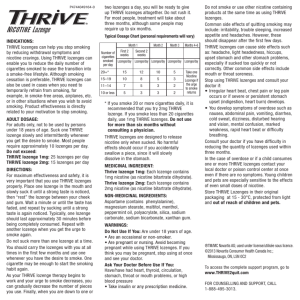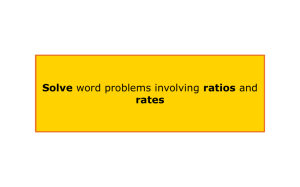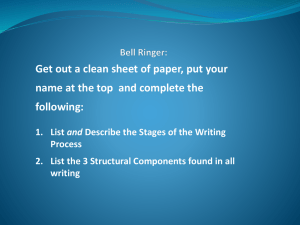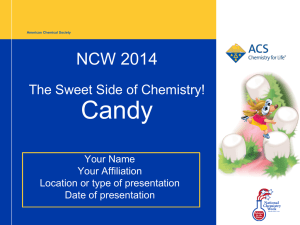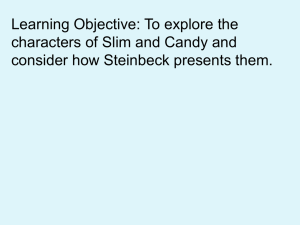Lozenges - Drud Delivery Vehicles
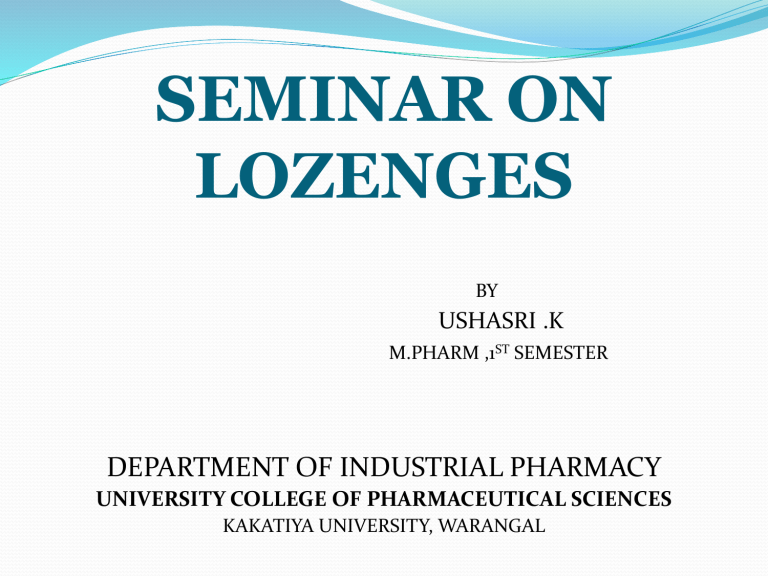
SEMINAR ON
LOZENGES
BY
USHASRI .K
M.PHARM ,1 ST SEMESTER
DEPARTMENT OF INDUSTRIAL PHARMACY
UNIVERSITY COLLEGE OF PHARMACEUTICAL SCIENCES
KAKATIYA UNIVERSITY, WARANGAL
CONTENTS
INTRODUCTION
SHAPES OF LOZENGES
TYPES OF LOZENGES
RAW MATERIALS
FORMULATION
MANUFACTURING
PACKAGING
STORAGE
QUALITY CONTROL
RECENT ADVANCES
CONCLUSION
INTRODUCTION
Lozenges are solid and flavored medicated dosage forms intended to be sucked and held in the mouth or pharynx.
They can be prepared by:
A) Molding
Ex: Pastilles
These are soft variety of lozenges contains medicament in gelatin or glycero gelatin base or acacia, sucrose, water.
B) Compression of sugar based tablets.
Ex: Troches
Lozenges are OTC and prescription products.
Provide drug delivery locally to the mouth and tongue, throat, etc.
Maximizes the local activity of the drug.
Contains variety of active ingredients like Local
Anesthetics, Antimicrobials, Antibiotics, vitamins,
Decongestants, Analgesics, Cough suppressants,
Nicotine like substances for smoking cessation.
Advantages over conventional tablets:
1. No disintegration
2. Slower dissolution rate
3. Pleasant taste
4. Organoleptic properties like color, smoothness
5. Slow release of medicament.
A
SHAPES OF LOZENGES:
Flat
Circular
Octagonal
Biconvex
Cylindrical
TYPES OF LOZENGES:
1.Medicated lozenges
Based on manufacturing
A) Hard candy lozenges i) Center filled hard candy lozenges
Liquid filled
Fruit centers
Paste centers
Fat centers ii) Chewy or caramel base medicated tablets
Caramels
Toffees
B) Compressed lozenges
Tablets compressed in weight range of 1.5- 4 g .
Large in diameter.
Having desired area of activity on mucous membrane and mouth.
2. Non medicated lozenges
*sugar candies,
*Lollypops.
Cough Drop (Throat lozenges)
A Cough drop is medicated candy intended to deliver active ingredients which suppress or relieve the cough reflex. They are made just like hard candies.
These are sweet in taste and good mouth feel characteristics.
BRANDS:
Capacol
Halls
Chloraseptic
Fishermans friend
Lokerol
Lockets
Ricola
Strepsils
Vicks
RAW MATERIALS
1.Hard candy lozenges a) Sugars:
Dextrose, sucrose, corn syrup, b) Acidulants:
Citric acid, Fumaric acid ,Tartaric acid, c) Colourants;
Dyes,Organic colourants.
d) Medicaments
Local anesthetics
Ex; Benzocain, Hexyl resorcinol,
Diperidon Hcl, Benzyl alcohol, Diclonine.
E) Antihistamines;
Chlorpheniramine maleate , Phenyltolaxamine
Dihydrogen citrate,Diphen hydramine HCl.
F)Antitussives;
Dextro methorphan hydrobromide.
g)Analgesics;
Asprin, Acetaminophen.
H)Decongestantants;
Phenyl propanolamine HCl, d-pseudo ephedrine
HCl.
A) For chewy or caramel base;
Candy base
Humectants
Lubricants
Medicaments
Seeding crystals
Flavours
B) Center filled hard candy lozenges
2)COMPRESSED TABLETS
1. Tablet base or vehicle : a) Sugars: Dextrose, Nu-tab, Royal T, Di-pac,
Sugar tab, Honey tab, Mola tab b) Sugar free vehicles: Sorbitol, Mannitol, Poly ethylene glycol-8000,6000 c) Other fillers: Dicalcium phosphate, calcium sulphate, calcium carbonate, Lactose, Micro crystalline cellulose
2. Binders:
Acacia, corn syrup, Sugar syrup, Gelatin,
Polyvinylpyrrolidine, Tragacanth, Methyl cellulose.
3. Colours:
Water soluble dyes and Lakolene dyes a
FORMULATION
1. Hard candy lozenges
A) Medicament-Flavour-Ground Salvage Method of
Addition
B) Direct Medicament Addition
Ex: Analgesic lozenges(162.5mg or 4 gm)
Ingredient Quantity
Ex: Analgesic lozenges(162.5mg or 4 gm)
Liquid sugar(67.5%)w/w cornsyrup
Ground candy solvage
Aspirin 100 mesh
Imitation orange flavour
Menthol crystals
Orange colour paste
88.9lb
49.7lb
2.0lb
1.85kg
35.0g
50.0g
12.0g
a
C) Medicament Addition via Granulation
D) Dual- Granulation Addition to Reduce chemical incompatibilities
E) Addition of Liquid salvage with colour
F) Addition of liquid salvage with colour and Medicament a a
Wet granulation techniques:
Antitussive-Anesthetic Lozenges(2.5g)
Ingredient Quantity
Dextromethorphan HBr 4.05%
Benzocaine 2 %
Confectioner sugar 58 %
Polyethylene glycol 15 %
Corn starch 12 %
Gelatin 3%
Spray dried powder Q.S
Lakolene colour Q.S
Magnesium stearate USP 0.5 %
Polyethylene glycol 8000 1.0 %
MANUFACTURING OF LOZENGES
1. Hard candy lozenges:
A) Cooking
3 types of candy base cookers a) Fire cookers b) High speed atmospheric cookers c) Vacuumed cookers cooking process
1. Precooked sugar glucose solution 1a. Feed pump
2. Steam chamber 2a. Steam supply 2b. Cooking coil 3 Vapours space 4. Extraction of vapours 5.
Valve 6. Vacuum chamber 7. Pan swiveling device
8. Discharge pan 9. Vacuum pump
B) Batch cookers
* Batch cookers working based on the principle of stirring .
* Produces lighter and more reproducible products.
1. Filling 2. Batch cooker 3. Beater 4a. Valve rod 4b. Valve operating wheel 5. Steam heating 6. Vacuum chamber 6a. Vacuum connection 7. Swivel device 8. Delivery pan with boiled sugar mass
C) Pure sugar cookers:
*The pure sugar cookers lend themselves to easy wash out sugar crystals which are formed on the sides of the kettle.
D) Standard vacuum cookers
*continuous batch process cooker
*Pre cooker
E) Cooking machines
F) Candy base preparation:
PRINCIPLE: The entire unit is heated to candy base cooking temperature by passing the steam into and around the copper coil.
G) Mixing
H) Batch processing
I) Rope sizing
J) Adjustment of weight
K) Lozenge formation
L) Cooling
M) Lozenge storage
2) Compressed Tablet lozenges a) Wet granulation
Anaesthetics, Antitussives b) Dry granulation
Analgesics, Antihistamine lozenges
Compression sequences:
A) Die -filling
B) weight adjustment
C) Compression hardness
Compression process
Packaging:
a)Individual bunch wrap it is Cellophane,Aluminium foil tissue paper impregnated with a wax or FDA food approved releasing agent.
c)Carton overwrap
Over wrapped with nitro cellulose cellophane or saran wrap and stored at 25c 0 with a relative humidity of 80%.
d)Bundle wrap
Waxed aluminium foil, saran wrap, poly propylene, waxed paper used.
e)Foil pouches: They employs aluminium foil as thin as 0.0008inch laminated with poly ethylene and tissue paper.
STORAGE: a
STORAGE:
The properly sized lozenges are transferred to a conditioning area i.e,
0
maintained at a temperature of 15 to 20c and controlled relative humidity of 25 to
35%.
Quality control tests
1)General checks
*Forming checks
*cooling checks
*Moisture analysis
2)Microbiological testing
Total plate count
Total coli form count
Staphylococcus ,Salmonella tests.
,
3)Batch release test
*Test for grittiness
*Dosage uniformity
4)Stability testing:
*Shelf life determination
*Flavour stability test
Physical stability study:
*Colour
*odour
*Taste
*Hardness,
*Bunch wrap
*Appearance
Recent advances
The USP currently recognizes Cetyl pyridinium chloride Lozenges and Nystatine lozenges.
Sublingual Zolpidem tartarate lozenge for the treatment of Insomnia was developed.
Bacitracin was developed in the form of lozenge for the treatment of infections caused after burns, scars etc.,.
Nicotine lozenges
These are the newest form of Nicotine replacement therapy on the market. The FDA recently approved the first Nicotine-containing lozenge as an over-thecounter aid in smoking cessation.
These are available in 2 strengths: 2 mg and 4 mg.
CONCLUSION
Lozenges are medicated confections designed to locally deliver drug to mouth and throat.
Provide slow dissolution and drug release.
These are totally different from other dosage forms in terms of ingredients, method of manufacturing ,therefore require specialized facilities.
For these and other reasons, lozenges are produced by few pharmaceutical manufacturers and represent a very small percentage of pharmaceutical sales .
REFERENCES
1.
2.
Habert a.Liberman, Lein Lachman, Joseph b. Schwartz, Pharmaceutical dosage forms
Tablets volume 1.
Martindale, The Extra Pharmacopoeia 29th Edition, 1989. The Pharmaceutical Press,
London.
3.
Remington's Pharmaceutical Sciences
18th Edition, 1990. Philadelphia College of Pharmaceutical Sciences.
4.
Principles and Practice of Disinfection, Preservation and Sterilization edited by AD Russell, WB Hugo and GAJ Ayliffe, 1982. Blackwell Scientific Publications.
5. www.pharmainfo.net
6.
Third Report of the Expert Advisory Committee, Nonprescription Cough Cold
Remedies
Ministry of National Health and Welfare, 1989. pp. 4-9.
7.
American Handbook of Nonprescription Drugs
9th edition ,1990, American pharmaceutical Association.
8.
Encyclopedia of Pharmaceutical Technology - by
James Swarbrick – 2007 pg 2231-2235.
